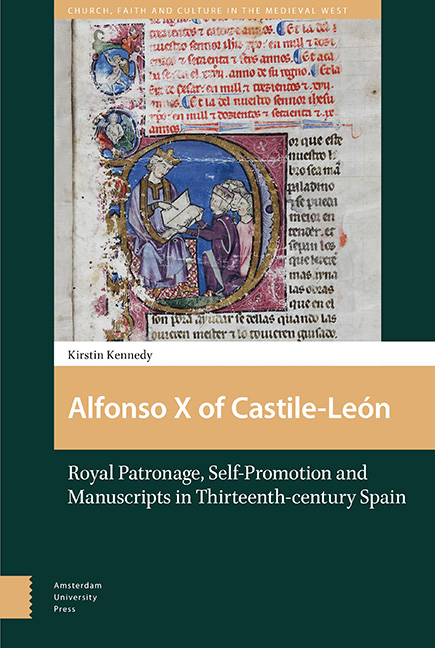 Alfonso X of Castile-León
Alfonso X of Castile-León Book contents
- Frontmatter
- Dedication
- Contents
- Acknowledgements
- List of Figures
- Abbreviations
- Introduction: ‘the king Makes a Book’
- 1 Alfonso X, his Literary Patronage, and the Verdict of Historians
- 2 Alfonso in his Texts: literary Models and Royal Authorship
- 3 Reality, Politics, and Precedent in Images of Alfonso
- 4 Codices Laid Out for a King : the Appearance and Production of Alfonsine Manuscripts
- 5 The Circulation of Alfonsine Texts: Astrological Works and Chronicles
- Concluding Remarks
- Manuscript Sources
- Index
3 - Reality, Politics, and Precedent in Images of Alfonso
Published online by Cambridge University Press: 21 November 2020
- Frontmatter
- Dedication
- Contents
- Acknowledgements
- List of Figures
- Abbreviations
- Introduction: ‘the king Makes a Book’
- 1 Alfonso X, his Literary Patronage, and the Verdict of Historians
- 2 Alfonso in his Texts: literary Models and Royal Authorship
- 3 Reality, Politics, and Precedent in Images of Alfonso
- 4 Codices Laid Out for a King : the Appearance and Production of Alfonsine Manuscripts
- 5 The Circulation of Alfonsine Texts: Astrological Works and Chronicles
- Concluding Remarks
- Manuscript Sources
- Index
Summary
The number and variety of images of Alfonso in the manuscripts he commissioned is striking in the context of representations of other royal patrons of the period, and suggests Alfonso's exceptional use of books to depict himself as a learned king divinely appointed to rule. The density of composition, prominence and frequency of these miniatures in the codices he patronized is in contrast with the single patron-images which accompany the colophon to the Bible copied around 1258 for Manfred of Sicily, or the colophon which concludes the moralized Bible commissioned by Louis IX (and which he presented to Alfonso). In other ways, however, Alfonso's self-representations reflect a wider trend of the period, which saw kings increasingly use images and sequences of images to promote messages about power and good government. The colophon miniatures in the Bibles copied for Manfred and Louis both emphasize the hierarchical nature of the commission and the superior status of the monarch. On a grander scale, Henry III of England (r. 1216–1272), commissioned paintings that included a mappa mundi and a Tree of Jesse for his Painted Chamber at the palace of Westminster in 1236 and, after this burned down in 1263, he replaced them with allegorical depictions of the virtues and vices. His successor Edward I (r. 1272–1307) added biblical scenes from the Book of Kings. The wider medieval public, meanwhile, would have been familiar with images of an enthroned king exercising power and dispensing justice: this was a familiar trope in religious contexts and it also served as an icon of royal government.
The images of Alfonso as author and patron are, like the texts they accompany, primarily intended to establish and promote his kingship, rather than to document the intellectual and physical process of production of the work. To convey this, the images draw on visual allusions to biblical kings such as David and Solomon, and incorporate established markers of regal authority such as heraldry as well as imagery less familiar to modern eyes which depends on the astrological symbolism associated with colour. As in the prologue texts, the artists carefully tailor their depictions of Alfonso to the work and its audience, and present him in very specific ways that are intended to convey a political message.
- Type
- Chapter
- Information
- Alfonso X of Castile-LeónRoyal Patronage, Self-Promotion and Manuscripts in Thirteenth-century Spain, pp. 111 - 152Publisher: Amsterdam University PressPrint publication year: 2019


